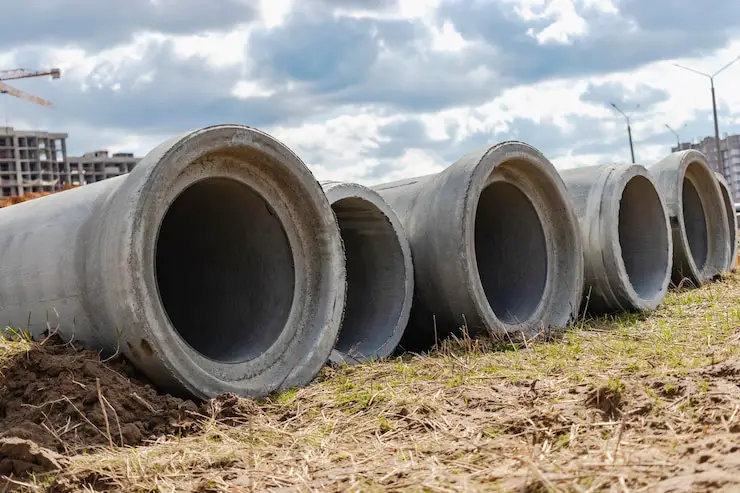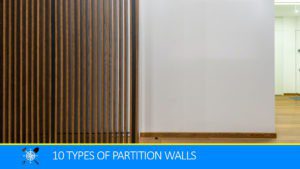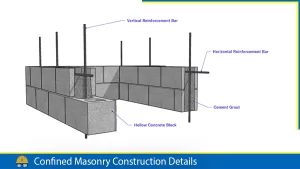Cement Concrete Pipes
Concrete pipes are cylindrical structures made primarily from a mixture of Portland cement, aggregates (such as sand and gravel), and water. It is a commonly used component in infrastructure projects, particularly in drainage systems, sewer networks, and culverts.
Concrete pipes are manufactured using various methods, including the spinning process and on-site casting. In the spinning process, a steel mould is rotated while the concrete mixture is poured into it, creating a uniform cylindrical shape. This method is commonly used for producing large quantities of concrete pipes with consistent quality.
Concrete pipes can also be pre-cast or prepared on-site. Pre-cast concrete pipes are manufactured in a controlled environment, usually in a factory or manufacturing plant, ensuring high-quality and standardized production. On the other hand, on-site preparation involves casting the concrete pipes directly at the construction site using temporary moulds or formwork.
Concrete pipes can be classified as plain or reinforced. Plain concrete pipes, also known as non-reinforced pipes, are made solely from the concrete mixture without any additional reinforcement. They are suitable for applications with lower water pressure and depths, typically up to 7 meters.
Reinforced concrete pipes, as the name suggests, incorporate reinforcement elements, usually steel bars or wire mesh, within the concrete structure. This reinforcement enhances the strength and durability of the pipe, allowing it to withstand higher water pressure and support larger heads, typically up to 60 meters.

Advantages Of Concrete Pipe
Concrete pipes are favoured in civil engineering projects such as construction drainage, sewer and water pipeline projects due to the following advantages:
- Durability: Concrete is renowned for its exceptional durability, with concrete pipes exhibiting resistance to corrosion, fire, and external forces. They can withstand challenging environments and provide long-lasting service life, reducing maintenance and replacement costs.
- Strength: Concrete pipes possess excellent structural strength, enabling them to bear heavy loads and resist deformation under pressure. Reinforced concrete pipes offer enhanced strength due to the inclusion of reinforcement elements.
- Chemical Resistance: Properly designed concrete mixes can be resistant to chemical attacks, such as sulphur or acidic substances, making them suitable for a wide range of applications, including sewer systems and industrial environments.
- Cost-effectiveness: Concrete pipes offer a reliable and cost-effective solution due to their longevity and minimal maintenance requirements. They require fewer repairs and replacements compared to alternative materials, resulting in reduced lifecycle costs.
- Reduce Frictional Loss: Concrete pipes have a smooth inner surface, which helps reduce internal frictional loss during the flow of fluids. The smoothness of the pipe interior allows for efficient movement of water, sewage, or other fluids, reducing energy requirements for pumping and minimizing pressure drop along the pipe network. This characteristic contributes to improved hydraulic performance and cost-effective operation of the system.
- Versatility: Concrete pipes are available in various sizes, diameters, and lengths, allowing flexibility in design and installation. They can be tailored to meet specific project requirements, ensuring efficient water flow and drainage systems.
- Advantages of being heavy: The inherent weight of concrete pipes exhibits natural resistance to floatation when they are empty. This characteristic is a significant advantage in applications where buoyancy control is crucial, such as in underground drainage systems or culverts located in areas with high water tables or flood-prone regions. The weight of the concrete pipe itself provides stability and prevents it from floating or becoming dislodged under the hydrostatic forces exerted by groundwater or floodwater.
Disadvantages
Although it has several advantages, it has some disadvantages too which are as mentioned below:
- Higher Initial Cost: Though maintenance cost is low, it is very difficult to repair them once there is damage in the pipe system They have a higher initial cost compared to alternative materials such as plastic pipes, which include the cost of manufacturing, handling and installation cost.
- Disadvantages of being heavy: The heavy weight of concrete pipes, which is advantageous in certain aspects, can also pose challenges during transportation, handling, and installation. Specialized equipment and techniques may be required to lift and maneuver the heavy pipes, increasing project costs and complexity.
- Cracking: Unreinforced pipes are susceptible to tensile cracks, and have limitations in withstanding high pressure. Concrete is strong in compression but weak in tension. Unreinforced concrete pipes are particularly vulnerable to tensile forces. When subjected to external loads or ground movement, the tensile stress on the pipe walls can exceed the tensile strength of concrete, leading to the development of cracks that may propagate and compromise the structural integrity of the pipe, potentially resulting in leakage or failure.
- Limited Pressure Capacity: Unreinforced pipes are not designed to withstand high-pressure applications. Due to their susceptibility to tensile cracking, they have inherent limitations in their ability to resist internal pressure.
- Tendency of leakage: The tendency of leakage is not ruled out as a result of its porosity and shrinkage cracks. Also, the lack of reinforcement in the pipe walls makes them more prone to bulging or failure when subjected to high-pressure conditions.
- Difficulty in transportation: Pre-cast pipes are very heavy, and it is difficult to transport them.
- Limited joint options: Concrete pipes typically have limited joint options compared to other pipe materials. Common joint types include bell and spigot, tongue and groove, or mechanical joints. While these joints provide adequate sealing, they may require additional care during installation to ensure proper alignment and prevent leaks.
Also, read:
- Joints for Concrete Pipes [pdf]
- Types of Traps: Functions And Used In Plumbing
- Manhole: Everything About It
![]()







